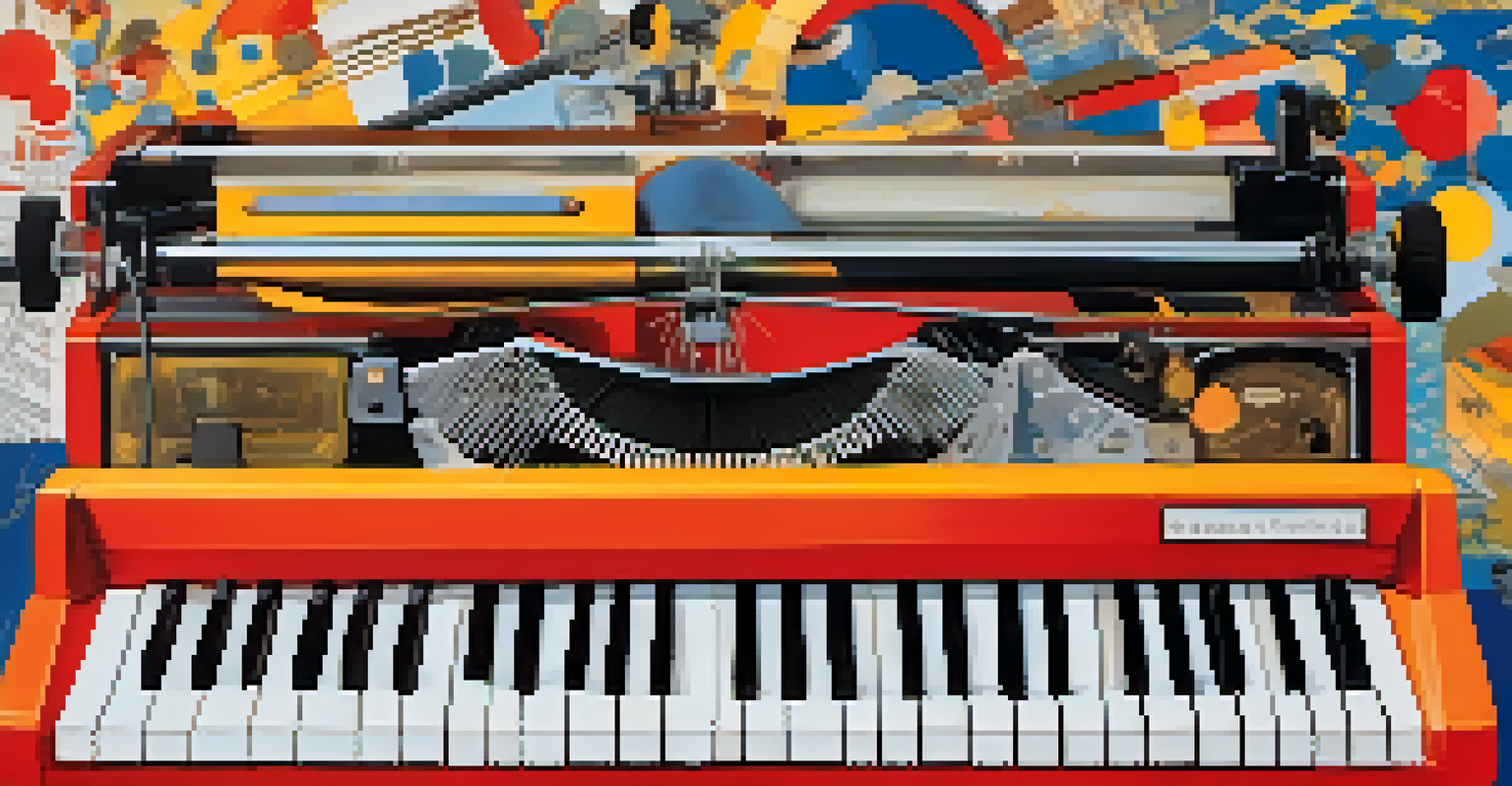The Impact of the Beat Generation on California Art

Understanding the Beat Generation's Origins in California
The Beat Generation emerged in the 1940s, primarily in New York City, but soon found its heart in California. This movement was marked by a rejection of mainstream values, embracing a more liberated lifestyle that encouraged experimentation in art, literature, and philosophy. California's vibrant culture provided a fertile ground for these ideas to flourish, attracting influential figures like Jack Kerouac and Allen Ginsberg.
The only thing that can save us is the spirit of the Beat Generation, and the spirit of the Beat Generation is the spirit of freedom.
California, with its diverse landscapes and bohemian enclaves like San Francisco's Haight-Ashbury, became a hub for artists seeking freedom of expression. The state's sunny disposition and laid-back lifestyle resonated with the Beat ethos, promoting a sense of community among artists. This environment encouraged collaboration, where poets, painters, and musicians could inspire one another.
As the Beats settled into California, they began to shape a unique artistic identity that blended their literary pursuits with visual arts. Their influence would ripple through the decades, impacting not just literature but the broader artistic landscape of California, making it a cornerstone of American counterculture.
Literary Contributions of the Beats to California's Art Scene
The literary works of the Beat Generation are perhaps their most significant contribution to California's art scene. Writers like Kerouac and Ginsberg utilized free verse and spontaneous prose to express their inner thoughts, challenging traditional artistic forms. Their writings not only captured the spirit of the times but also inspired visual artists to explore similar themes of freedom and rebellion.

These literary innovations created a ripple effect, encouraging painters and sculptors to adopt more abstract and unconventional styles. Artists began to experiment with new techniques, mirroring the Beats' focus on personal expression and the exploration of consciousness. The connection between literature and visual art became increasingly pronounced during this time.
Beat Generation's Influence on Art
The Beat Generation fundamentally reshaped California's art scene by challenging traditional norms and inspiring diverse artistic expression.
Furthermore, the Beats often hosted readings and gatherings that attracted a diverse mix of creatives. These events fostered a cross-pollination of ideas, where the lines between different art forms blurred, creating a dynamic and inclusive artistic community in California.
Visual Artists Influenced by the Beat Movement
The Beat Generation's ethos of nonconformity resonated deeply with many visual artists in California. Artists like Robert Rauschenberg and Jasper Johns found inspiration in the Beat's rejection of traditional aesthetics. Their work often reflected the same spirit of experimentation and spontaneity that characterized Beat literature, leading to groundbreaking pieces that challenged the status quo.
I think the Beat Generation is the last generation that had a philosophy of life, a way of living, a way of being, that was not tied to the consumer culture.
In the San Francisco Bay Area, artists like Bruce Conner and Joan Brown became known for their innovative approaches that echoed Beat themes. They utilized collage, assemblage, and other mixed media techniques to create art that was as much about the process as the finished product. This shift towards a more participatory and experiential form of art mirrored the Beats' own creative philosophies.
The influence of the Beats can also be seen in the rise of the California Funk Art movement, which embraced humor and absurdity. This playful approach to art, linked to the Beat's irreverent attitude, encouraged artists to explore the boundaries of both aesthetics and societal norms.
The Role of Music in the Beat Generation's Artistic Expression
Music was a vital element of the Beat Generation, serving as both inspiration and a form of artistic expression. Jazz, in particular, resonated with the Beats, who embraced its improvisational nature as a parallel to their writing style. Musicians like Charles Mingus and Thelonious Monk provided the soundtrack to the Beats' creative explorations, influencing their rhythms and themes.
The Beats' passion for music often found its way into their poetry readings, where live performances created an electrifying atmosphere. This blending of poetry and music not only enhanced the artistic experience but also attracted a broader audience, further solidifying the connection between these art forms. Events like the Six Gallery reading in San Francisco exemplified this fusion, marking a pivotal moment in the Beat movement.
Literary Innovation and Collaboration
Writers like Jack Kerouac and Allen Ginsberg pioneered new literary forms that encouraged cross-disciplinary collaboration among artists.
As the Beat Generation evolved, so did its musical influences, paving the way for genres like folk and rock that would later dominate California's music scene. Artists such as Bob Dylan and The Grateful Dead drew from Beat ideals, creating a lasting impact that extended beyond literature and visual arts.
Cultural Impact of the Beat Generation on California Art
The cultural impact of the Beat Generation on California art cannot be overstated. Their radical ideas challenged societal norms and encouraged artists to explore themes of identity, spirituality, and social justice. This shift in perspective led to a more inclusive art scene that welcomed diverse voices and experiences, reshaping the artistic landscape of California.
As the Beats gained prominence, their influence permeated various cultural institutions, including galleries, performance spaces, and literary festivals. These venues became platforms for emerging artists to showcase their work, fostering a sense of community and collaboration. The Beats’ legacy can still be seen today in the thriving art scene of cities like Los Angeles and San Francisco.
Moreover, the Beat Generation's focus on authenticity and personal expression inspired subsequent movements, including the countercultural upheavals of the 1960s. Their impact on California art laid the foundation for a vibrant creative ecosystem that continues to evolve, encouraging artists to push boundaries and challenge conventions.
The Beat Generation's Lasting Legacy in California Art
The legacy of the Beat Generation is evident in the ongoing evolution of California art. Their emphasis on individualism and experimentation has set a precedent for artists to explore uncharted territories in their work. Today, many contemporary artists draw inspiration from the Beats, incorporating elements of spontaneity and personal narrative into their creations.
Moreover, the Beat Generation's ethos has contributed to the rise of various art movements that prioritize social commentary and activism. Artists are now more inclined to address pressing societal issues through their work, reflecting the Beat's commitment to challenging the status quo. This ongoing dialogue about art and culture keeps the spirit of the Beats alive and relevant.
Legacy of Rebellion and Authenticity
The Beats' emphasis on individualism and social commentary continues to inspire contemporary artists to explore uncharted territories in their work.
Additionally, the Beats' influence extends beyond the visual arts; it has also shaped literature, music, and film. Their ideas continue to inspire new generations of creatives, ensuring that the core values of the Beat Generation remain a vital part of California's artistic identity.
Conclusion: The Beat Generation's Influence on Today's Art
In conclusion, the Beat Generation has left an indelible mark on California's art scene, shaping its trajectory for decades. Their pioneering spirit and dedication to authenticity have inspired countless artists to embrace their own unique voices. This legacy of innovation and rebellion continues to thrive, making California a vibrant hub for creative expression.
Today, the fusion of various artistic disciplines—literature, visual arts, music, and performance—echoes the collaborative spirit fostered by the Beats. As artists explore new mediums and themes, they carry forward the lessons learned from this groundbreaking movement, pushing the boundaries of what art can be.

Ultimately, the impact of the Beat Generation on California art serves as a reminder of the power of creativity to challenge norms and inspire change. Their influence will continue to resonate, encouraging future generations to embrace their artistic journeys with courage and authenticity.